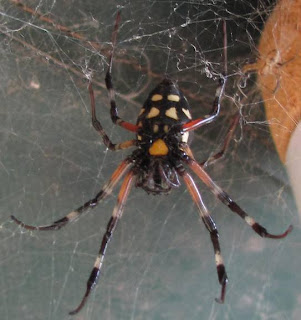- - Black Button/Widow Spider: (Family Theridiidae - Latrodectus
indistinctus/renivulvatus/cinctus/karooensis) Almost every major region of
Africa has at least one of these species present, with the greatest density occurring
in Southern Africa. In Kenya, Latrodectus renivulvatus seems to be the only species present. Black Button Spiders
can inject strong neurotoxic venom, potentially causing heart palpitations,
severe anxiety, chest pains and difficulty breathing. However, these spiders are shy, retreating,
and not aggressive. They are bound to their webs and will most often go out of their way to AVOID humans. They also have a
habit of wrapping their prey in silk before injecting venom, further reducing
the chances of receiving a bite. Victims
should be kept calm and reassured that they will be fine. However, medical attention should be sought
as soon as possible, and antivenin should only be administered after observing
real symptoms by a qualified medical professional.
African Black Button
Spiders are generally almost completely black with some variation of a red
marking on the dorsal (top) side of the abdomen. This differs from some North American Species
which are known for their red hour-glass markings on the ventral (under) side of
the abdomen. Black Buttons create messy
looking space-webs, and often have several smooth round white egg casings in a
retreat to one side of the web.
Latrodectus renivulvatus: Note the distinctive red markings on the top and back of the abdomen. Photo credit: Rudi Steenkamp (Wikimedia Commons License)
Similar specie: False Button Spiders (also Theridiidae, genus
Steatoda) can easily be confused for a Black Button, except for the lack of any
red markings on the abdomen. Some have
whitish/creamy markings on the abdomen.
Although, the venom from Steatoda is not nearly as toxic as that from
Latrodectus, it can still produce a fair amount of pain and dizziness.
 |
| Steatoda sp. - FALSE BUTTON SPIDER (female): Notice the lack of any red markings on the top of the abdomen. |
 |
| Steatoda sp. - FALSE BUTTON SPIDER (female): Notice the lack of any red markings on the top of the abdomen. |
- Brown Button Spider: (Family Theridiidae - Latrodectus
geometricus): L. geometricus is one of the most widely spread
spiders in the world, and occurs across every continent (other than
Antarctica). The venom from Brown Button Spiders (also
neurotoxic) is generally considered to be only 1/4th as virulent as that of the
Black Buttons. Symptoms of a Brown
Button bite would be similar to those of a Black Button, but to a much lesser
extent.
Brown Buttons vary from
black to light brown with various markings on the top of the abdomen and a
distinct red hourglass marking on the ventral side of the abdomen. Their webs are similar to those of Black
Buttons, but their round egg sacs are covered in spikes, rather than being
smooth.
 |
| Latrodectus geometricus - Brown Button Spider: Very distinct red "hourglass" marking showing under the abdomen. The often hang upside down in their webs, making this marking very visible. |
 |
| Latrodectus geometricus - Brown Button Spider: With Solifuge prey. |
House Button Spiders are also members ore Theridiidae, but are similarly harmless to humans


.jpg)


.JPG)


.JPG)

+Baboon+Spider.jpg)
+-+Baboon+Spider.JPG)
.jpg)

+(1).JPG)
+(2).JPG)
.jpg)
.JPG)


+(2).JPG)
+(3).JPG)